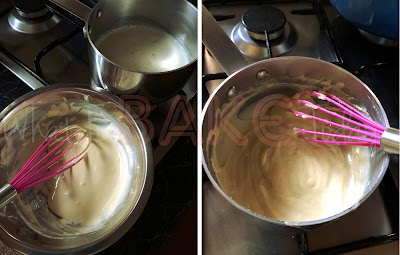The same quest continues this year, but nothing suitable came out from my internet research. Coincidentally, there was a travel show on TV, featuring traditional Lithuanian 12 course Christmas eve dinner which is strongly tied to their religious beliefs. It consists of no hot food, no dairy products, no meat and supposedly, rather bland. For dessert, the dinner ends with Kūčiukai which are bite-sized, yeast leavened poppy seed biscuits, and the older generations will pour aguonų pienas (adhering to the non dairy restriction) over the biscuits and enjoy them like cereal. Aguonų pienas is a whitish drink made by repeatedly crushing soaked poppy seeds, aptly translated to poppy seed milk. The process is quite laborious, so some younger generations have updated with time, and prefer to enjoy the biscuits with a glass of cold milk on the side.
Kūčiukai (makes about 100 pieces)
250g Plain flour
25g Poppy seeds
3g Salt
30g Butter, unsalted, melted
100g Warm water, about 35˚C, no higher than 40°C
50g Sugar
7g Yeast
Preheat oven to 180˚C
1. Add sugar and yeast to warm water, mix and leave to activate for about 5 mins.
2. Add the poppy seeds and salt to flour and mix it briefly till they are evenly distributed.
3. Add in the melted butter and yeast mixture to the flour. Then using a hook attachment, mix the ingredients on med-high speed for approximately 5 mins. The dough should feel soft and slightly sticky when done.
4. On a lightly floured surface, hand knead the dough for about 2-3 mins until it is no longer tacky to touch. Form the dough into a smooth round ball and place it in a lightly oiled bowl. Cover with cling wrap and leave it in a warm place to prove for 1-2 hours.
4. Divide the dough into 4 pieces and roll each into a snake-like rope, about 2cm in thickness. Then cut the rope into approximately 2cm individual pieces.
5. Place the dough pieces on a lined baking sheet with a spacing of 0.5cm. Bake for 13-16 minutes until the edges are golden brown and slightly crisp.
6. Leave to cool completely on a wired rack before storing in a biscuit tin or airtight container.
Thoughts: I quite like the idea of traditional Lithuanian Christmas dinner, not just because they're still closely related to their religion but also that they take it as time to remember their deceased. In fact, Kūčiukai is supposed to be a form of ritual bread meant for the souls; its bite size to represent that souls have no material bodies and making a lot of them to represent the sheer number of souls. The unfinished food will also be left on the table overnight as it is believed that their deceased loved ones will visit in the night and feel welcome by the spread. I can resonate with their beliefs because I tend to think more of my beloved grandparents during festive celebrations. Things are different when loved ones are no longer here, but I think it's heart warming that they still try to "involve" the deceased into their celebrations.
Like aforementioned, a traditional Lithuanian Christmas dinner should be meatless, non-dairy and consists of no hot food. But since I'm just after a healthier Christmas sweet, I chose this recipe that includes a minimal amount of butter for a little flavour. If for health, religious or whatever reasons, butter can't be consumed, these can remain a vegan snack by replacing the butter with equal amount of neutral tasting vegetable oil such as canola.
Although Kūčiukai is labelled a biscuit, it's texture and taste is more bread-like. Softer than biscuit, firmer than scone, with a prominent yeast taste. To be frank, I didn't like it at all on my first bite simply because it wasn't what I expected of biscuits. But as I ate more, the taste grew on me. Slightly nutty, a little salty, a little sweet. Perhaps this is one of those food that requires an acquired taste, just like sambal petai! Or maybe I just wasn't used to it. Either way, I love them now and had since made 3 batches to share with my family. It's a lot healthier compared to the usual holiday sweets. Try them this holiday season, and celebrate Christmas without having to worry about putting on weight.
Su šventomis Kalėdomis!
All blog posts and photos are properties of WhatToBakeToday (unless otherwise stated). Unauthorized use and/or duplication of these contents, whole or part thereof, without express or written permission from this blog's author is strictly prohibited. Excerpts and links may be used, provided that full and clear credit is given to WhatToBakeToday with appropriate and specific direction to the original content.








































